Dream Within A Dream
Artist: Adriana Duque
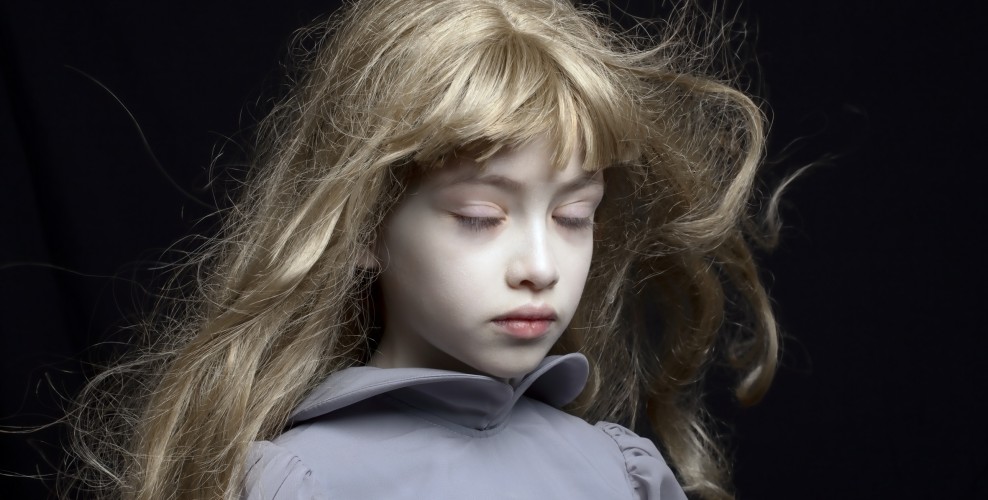
Artist: Adriana Duque
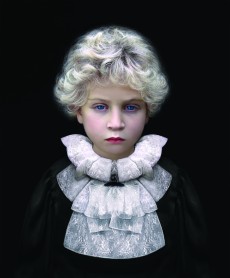 In dreams, the elements that seem the most real can be the most astonishing – bolstering the surrealism and disorienting our sense of place in reality. Colombian photographer Adriana Duque’s beautifully composed, psycho-culturally dense photographs underline this principle well.
In dreams, the elements that seem the most real can be the most astonishing – bolstering the surrealism and disorienting our sense of place in reality. Colombian photographer Adriana Duque’s beautifully composed, psycho-culturally dense photographs underline this principle well.
Duque’s perfect subjects are children, and the split-reality that they, like dreamers, instinctively inhabit. However, her skewing tableaus dissect not only childhood conceptions but also the extensions of our adult psyche: our rites of passage, our cultural products, our grown-up myths.
In these, as in Duque’s work, it’s the interjection of the real seeming into the fantastical that most eloquently subverts our precepts of reality. Objects of lucidity are layered across time-and-space-bending idealized and fantasized scenarios. Likewise, hyperrealism is attenuated by escapism. Within the balance, Duque inches deceptively close to an ultimately elusive reality.
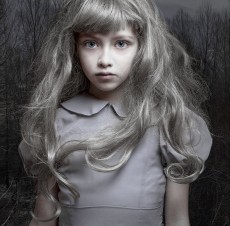 What significance does the dream-state hold for you and your work?
What significance does the dream-state hold for you and your work?The dream-state defines a place where nothing is controlled by reason; like quicksand, like dark and light at the same time – undecipherable. It’s the same Promised Land on the other side of the mirror from which I derive my obsession with Alice and her ability to travel through parallel-realities. Her constant physical and emotional fluctuations, her uncontrollable swings from sleep to vigil, and her pseudo-rational questions are all conceptual elements I systemically add to my work.
Children represent a conglomerate of ideas and emotions that remains uncultivated; their contact with reality and the adult-world is defined by sometimes-limitless fantasy. I’m drawn to their perceptions…their ability to split reality…and the instinctive drive reflected on their faces. They’re both the raw materials and the final product of my work.
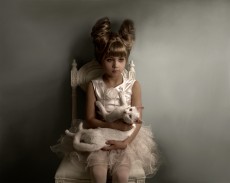 We never outgrow fairy tales – they reincarnate as myth. Discuss the role of fairy tales and myth in society and in your work.
We never outgrow fairy tales – they reincarnate as myth. Discuss the role of fairy tales and myth in society and in your work.I’ve always believed that fairy tales and myths are archetypal mirrors of society. They give meaning to values and emotions unchanged across culture and time. Their characters embody complex existential subjects, but it’s as if every story were a game; the players a series of emotions, values, anti-values, and dreams.
My work could be interpreted as absolute fiction, or, as connected to characters within my environment – my own unique history.
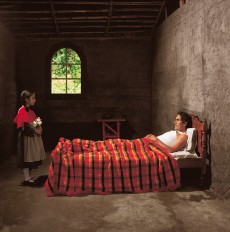 What is happening to the children in From Tale to Tale and Sleep Disorders?
What is happening to the children in From Tale to Tale and Sleep Disorders?In both series, like in fairy tales, children interact with the adult characters through an odd and irregular dialogue. All kinds of tensions: psychological, cultural, and sexual, are exposed. An intentional disarrangement of reality, the feeling of not belonging to imposed social-structures, the anxiety, the fear, and the isolation are all evident.
In From Tale to Tale, children look captive or abandoned without escape. In Sleep Disorders, Alice’s myth comes to life and imagination surpasses the austere reality. I present a gateway to escape, in this case from poverty and 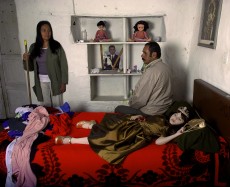 hopelessness, to another world that is strange but perhaps more promising.
hopelessness, to another world that is strange but perhaps more promising.
More than a distancing effect, I attempt to create an astonishing effect. Astonishment is an effective and affective way to approximate reality. It has the power to capture us with wonder, even if for a brief second. I want to create a reaction in the viewer through beholding something familiar but undecipherable at once.
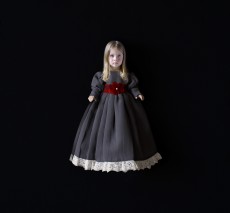 Icons and Collectibles are particularly interesting, respectively, for their juxtapositions and for their comment upon objectification. What are the concepts behind each series?
Icons and Collectibles are particularly interesting, respectively, for their juxtapositions and for their comment upon objectification. What are the concepts behind each series?In Collectibles, girls float undisturbed in the dark; a symbiosis between girl and porcelain doll. They’re offered in a virtual-market as a collectible piece, and personify some of the objectification of the female body.
In Icons, ‘princesses’ adopt the noble attire and charm of royalty, while rustic kitchens and rural backgrounds suggest a different, less glamorous reality.
In the end, it’s about the inexorable search for an ideal beauty governed by an unfamiliar stereotype.
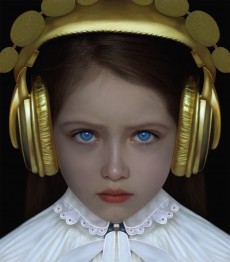 As in a dream, in your work there’s always jarring uncertainty regarding what’s real or illusion. How, if at all, is this aided by the digital aspect?
As in a dream, in your work there’s always jarring uncertainty regarding what’s real or illusion. How, if at all, is this aided by the digital aspect?My images sit in the middle of reality and fiction. Digital manipulation is merely a tool to reinforce the unbelievable condition defined by the characters. Children have an inherent, undecipherable nature that produces a halo so extraordinary it can hardly be the result of a digital trick! I’m not denying the endless possibilities of digital technology, but it is a resource that I mete-out for effectiveness.
Something magical and surprising happens on set after I’ve designed the costume for my character. That character, in costume and make-up before my camera, is suddenly recognizable; is precisely the character that was living in my imagination. At that point, I don’t see the costume. To the contrary, the whole ensemble brings the characters back to their original appearance and their immemorial attire.
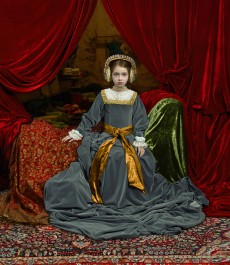 Your work is so layered, but it’s also simply beautiful. Is costume or even fashion something that interests you on a personal level?
Your work is so layered, but it’s also simply beautiful. Is costume or even fashion something that interests you on a personal level?When I was a girl, I spent hours in my grandmother’s library looking through the Universal Encyclopedia of Art, admiring the faces and attire of the strange characters masterly painted in those pages. I’d absorb every detail of the pleats in the silky dresses, the lace, the velvet, the jewelry design, the complicated hairdos, etc. Fashion as an affirmation of what is beautiful has always been my true obsession. I‘m always confirming, in modern fashion, these observations about classical attire.
There are many photographers whose work I consider interesting and outstanding. To name a few: Richard Billingham, Anthony Goicolea, Ruud Van Empel, Hellen Van Meene, Justine Kurland, Anna Gaskell, Qingsong Wang, and Rineke Dijkstra.
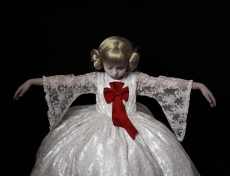 Can you discuss your most current work?
Can you discuss your most current work?I am currently working on an autobiographical series called The Other Side, which includes digital and analog photography, video and drawings.
-Larissa Zaharuk
More of Adriana Duque’s work: www.adrianaduque.com/intro.html